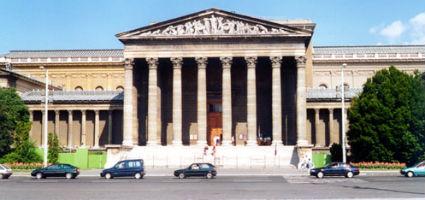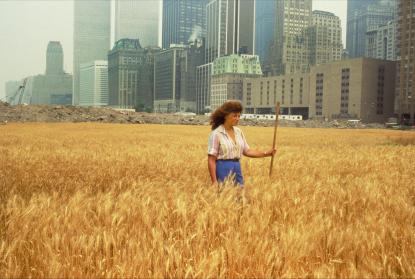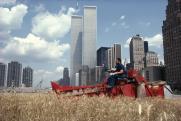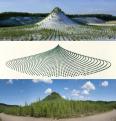2025. May 1. Thursday
Budapest Museum of Fine Arts - Budapest
 |
Address: 1146, Budapest Dózsa György út 41.
Phone number: (1) 469-7100
E-mail: info@szepmuveszeti.hu
Opening hours: Tue-Sun 10:00-18:00
|
Museum tickets, service costs:
|
Ticket for adults
(valid for the permanent exhibitions)
|
2800 HUF
|
/ capita
|
|
Ticket for adults
|
3200 HUF
|
|
|
Group ticket for adults
|
2900 HUF
|
|
|
Ticket for students
(valid for the permanent exhibitions)
|
1400 HUF
|
/ capita
|
|
Ticket for students
|
1600 HUF
|
|
|
Group ticket for students
|
1400 HUF
|
|
|
Ticket for pensioners
(valid for the permanent exhibitions)
|
1400 HUF
|
/ capita
|
|
Audio guide
|
800 HUF
|
|
|
Video
|
1000 HUF
|
The exhibition presents the landmarks in the oeuvre of Agnes Denes through representative series of graphic and photographic works, drawings, photo documentations and videos. Visitors can see some 60 works by the Hungarian-born American artist, who is one of the defining figures of international contemporary art.

Agnes Denes was born in 1931 in Budapest, moved to Sweden as a teenager with her family, and settled in the United States in the 1950s. She experimented with poetry in her youth before turning to the visual arts. In the late 1960s, she moved beyond the constraints of painting to begin a systematic visual and philosophical exploration of many disciplines using and reinterpreting the universal body of human knowledge: mathematics, philosophy, ecology, sociology and psychology. Her works combining various media and trends were among the first to integrate the ecological approach into fine arts. Several trends of the environmentally and socially engaged art of our times would be inconceivable without the initiatives made by Agnes Denes. Her conceptually rooted art is equally linked to the genres of land art and environmental art, as well as to poetry, philosophy, graphic art and installation art. In the early 1970s, Denes coined the phrase Eco-Logic, which fuses the two pillars of her art: ecology and logic.
An homage to one of her monumental works was at the focus of this year’s Art Basel fair. She continues to create environmentally-conscious public actions, which are radical interventions into the landscape or the urban tissue. One of her most emblematic works is Wheatfield – A Confrontation (1982), an action during which she sowed an area of 0.8 hectares with wheat and harvested it on a landfill in the southern end of Manhattan, near the then still standing twin towers, with the help of volunteers. The intrusion of landscape into the metropolis of New York called attention not only to environmental issues but also to economic and social problems too. Her similarly epochal work was the collaborative project titled Tree Mountain – A Living Time Capsule (1982–1996), within the framework of which eleven thousand trees were symbolically planted by eleven thousand people in Finland in a formation based on a mathematical formula. As the artist said, the trees of this mathematical forest “must outlive the present era and, by surviving, carry our concepts into an unknown time in the future.”
Agnes Denes creates her works as messages for future generations, and even for future civilisations. Considering the climate and ecological crises of the present era, her projects and messages could not be more topical. Her unique art is a testament to a special sensitivity to the environment and teaches all of us that an ecological catastrophe can be avoided in a sustainable system of nature, human values, and knowledge.
The exhibition at the Museum of Fine Arts, Budapest focuses on the pivotal themes and projects in the extraordinary oeuvre of Agnes Denes. It includes photo documentations of the artist’s most emblematic ecological projects, including the already-mentioned Wheatfield – A Confrontation (1982). With her Pyramid series – which she started in the 1970s and is still expanding – as well as her analytical works, such as Philosophical Drawings and Isometric Systems in Isotropic Space – Map Projections, she draws attention to the paradox inherent in Western knowledge. Her photo series titled The Kingdom Series throws light on the operation of micro- and macrostructures in nature. Besides the artist’s representative graphic and photo series, the displayed photo documentations and videos provide visitors with an insight into Agnes Denes’s most significant open-air and environmental projects.
The curator of the exhibition is Mónika Kumin, art historian at the Museum of Fine Arts – Hungarian National Gallery, Budapest.

Agnes Denes was born in 1931 in Budapest, moved to Sweden as a teenager with her family, and settled in the United States in the 1950s. She experimented with poetry in her youth before turning to the visual arts. In the late 1960s, she moved beyond the constraints of painting to begin a systematic visual and philosophical exploration of many disciplines using and reinterpreting the universal body of human knowledge: mathematics, philosophy, ecology, sociology and psychology. Her works combining various media and trends were among the first to integrate the ecological approach into fine arts. Several trends of the environmentally and socially engaged art of our times would be inconceivable without the initiatives made by Agnes Denes. Her conceptually rooted art is equally linked to the genres of land art and environmental art, as well as to poetry, philosophy, graphic art and installation art. In the early 1970s, Denes coined the phrase Eco-Logic, which fuses the two pillars of her art: ecology and logic.
An homage to one of her monumental works was at the focus of this year’s Art Basel fair. She continues to create environmentally-conscious public actions, which are radical interventions into the landscape or the urban tissue. One of her most emblematic works is Wheatfield – A Confrontation (1982), an action during which she sowed an area of 0.8 hectares with wheat and harvested it on a landfill in the southern end of Manhattan, near the then still standing twin towers, with the help of volunteers. The intrusion of landscape into the metropolis of New York called attention not only to environmental issues but also to economic and social problems too. Her similarly epochal work was the collaborative project titled Tree Mountain – A Living Time Capsule (1982–1996), within the framework of which eleven thousand trees were symbolically planted by eleven thousand people in Finland in a formation based on a mathematical formula. As the artist said, the trees of this mathematical forest “must outlive the present era and, by surviving, carry our concepts into an unknown time in the future.”
Agnes Denes creates her works as messages for future generations, and even for future civilisations. Considering the climate and ecological crises of the present era, her projects and messages could not be more topical. Her unique art is a testament to a special sensitivity to the environment and teaches all of us that an ecological catastrophe can be avoided in a sustainable system of nature, human values, and knowledge.
The exhibition at the Museum of Fine Arts, Budapest focuses on the pivotal themes and projects in the extraordinary oeuvre of Agnes Denes. It includes photo documentations of the artist’s most emblematic ecological projects, including the already-mentioned Wheatfield – A Confrontation (1982). With her Pyramid series – which she started in the 1970s and is still expanding – as well as her analytical works, such as Philosophical Drawings and Isometric Systems in Isotropic Space – Map Projections, she draws attention to the paradox inherent in Western knowledge. Her photo series titled The Kingdom Series throws light on the operation of micro- and macrostructures in nature. Besides the artist’s representative graphic and photo series, the displayed photo documentations and videos provide visitors with an insight into Agnes Denes’s most significant open-air and environmental projects.
The curator of the exhibition is Mónika Kumin, art historian at the Museum of Fine Arts – Hungarian National Gallery, Budapest.



